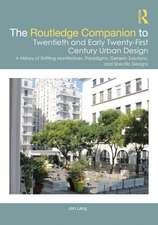Drivers of Integration and Regionalism in Europe and Asia: Comparative perspectives: Routledge Research in Comparative Politics
Editat de Louis Brennan, Philomena Murrayen Limba Engleză Paperback – 7 feb 2017
Comprising contributions from scholars, analysts and policymakers, this volume explores and debates how and why regional bodies such as the European Union (EU) and the Association of Southeast Asian Nations (ASEAN) are formed and sustained. Furthermore, it examines the drivers of, and impediments to, regionalism and integration. The debates regarding what and who constitute drivers are presented in a fresh, thematic and comprehensive manner. Leadership and core states are also critically examined, whilst material, ideational and normative factors are all assessed comparatively. Significantly, in light of the global financial crisis, the book considers the role of crisis as a driver of regionalism and integration.
This book will be of interest to students, scholars and policymakers interested in Asian and European politics and comparative politics.
| Toate formatele și edițiile | Preț | Express |
|---|---|---|
| Paperback (1) | 489.26 lei 6-8 săpt. | |
| Taylor & Francis – 7 feb 2017 | 489.26 lei 6-8 săpt. | |
| Hardback (1) | 1066.72 lei 6-8 săpt. | |
| Taylor & Francis – 26 mai 2015 | 1066.72 lei 6-8 săpt. |
Din seria Routledge Research in Comparative Politics
- 9%
 Preț: 1039.13 lei
Preț: 1039.13 lei -
 Preț: 385.40 lei
Preț: 385.40 lei - 9%
 Preț: 1005.50 lei
Preț: 1005.50 lei -
 Preț: 191.93 lei
Preț: 191.93 lei - 18%
 Preț: 1002.80 lei
Preț: 1002.80 lei -
 Preț: 495.94 lei
Preț: 495.94 lei - 18%
 Preț: 1056.47 lei
Preț: 1056.47 lei - 30%
 Preț: 333.04 lei
Preț: 333.04 lei - 18%
 Preț: 1054.27 lei
Preț: 1054.27 lei - 18%
 Preț: 1075.49 lei
Preț: 1075.49 lei - 18%
 Preț: 1058.79 lei
Preț: 1058.79 lei - 18%
 Preț: 1062.98 lei
Preț: 1062.98 lei -
 Preț: 413.76 lei
Preț: 413.76 lei - 18%
 Preț: 1062.98 lei
Preț: 1062.98 lei - 18%
 Preț: 1059.00 lei
Preț: 1059.00 lei -
 Preț: 425.86 lei
Preț: 425.86 lei - 18%
 Preț: 1106.36 lei
Preț: 1106.36 lei - 18%
 Preț: 1058.65 lei
Preț: 1058.65 lei - 18%
 Preț: 1061.06 lei
Preț: 1061.06 lei - 18%
 Preț: 1058.79 lei
Preț: 1058.79 lei - 15%
 Preț: 671.28 lei
Preț: 671.28 lei - 18%
 Preț: 1062.98 lei
Preț: 1062.98 lei -
 Preț: 334.41 lei
Preț: 334.41 lei - 18%
 Preț: 1055.21 lei
Preț: 1055.21 lei - 18%
 Preț: 1056.80 lei
Preț: 1056.80 lei - 18%
 Preț: 956.83 lei
Preț: 956.83 lei - 18%
 Preț: 1064.01 lei
Preț: 1064.01 lei - 18%
 Preț: 1057.05 lei
Preț: 1057.05 lei - 18%
 Preț: 1068.18 lei
Preț: 1068.18 lei - 18%
 Preț: 1217.29 lei
Preț: 1217.29 lei - 15%
 Preț: 701.96 lei
Preț: 701.96 lei - 18%
 Preț: 703.93 lei
Preț: 703.93 lei - 18%
 Preț: 703.09 lei
Preț: 703.09 lei - 18%
 Preț: 1065.30 lei
Preț: 1065.30 lei - 18%
 Preț: 1059.48 lei
Preț: 1059.48 lei - 28%
 Preț: 819.25 lei
Preț: 819.25 lei - 18%
 Preț: 1055.51 lei
Preț: 1055.51 lei - 18%
 Preț: 1052.35 lei
Preț: 1052.35 lei - 28%
 Preț: 849.37 lei
Preț: 849.37 lei - 18%
 Preț: 999.82 lei
Preț: 999.82 lei - 18%
 Preț: 1059.84 lei
Preț: 1059.84 lei -
 Preț: 392.48 lei
Preț: 392.48 lei - 18%
 Preț: 1064.52 lei
Preț: 1064.52 lei -
 Preț: 502.30 lei
Preț: 502.30 lei - 18%
 Preț: 1006.60 lei
Preț: 1006.60 lei - 18%
 Preț: 1066.09 lei
Preț: 1066.09 lei
Preț: 489.26 lei
Nou
Puncte Express: 734
Preț estimativ în valută:
93.62€ • 100.11$ • 78.06£
93.62€ • 100.11$ • 78.06£
Carte tipărită la comandă
Livrare economică 18 aprilie-02 mai
Preluare comenzi: 021 569.72.76
Specificații
ISBN-13: 9781138714519
ISBN-10: 1138714518
Pagini: 432
Ilustrații: 18
Dimensiuni: 156 x 234 mm
Greutate: 0.45 kg
Ediția:1
Editura: Taylor & Francis
Colecția Routledge
Seria Routledge Research in Comparative Politics
Locul publicării:Oxford, United Kingdom
ISBN-10: 1138714518
Pagini: 432
Ilustrații: 18
Dimensiuni: 156 x 234 mm
Greutate: 0.45 kg
Ediția:1
Editura: Taylor & Francis
Colecția Routledge
Seria Routledge Research in Comparative Politics
Locul publicării:Oxford, United Kingdom
Public țintă
PostgraduateCuprins
Section 1: Drivers of Regionalism: The European and Asian Cases Compared 1 Introducing Drivers of Integration and Regionalism Europe and Asia Louis Brennan and Philomena Murray 2 Drivers of regional integration: some comparative considerations Philomena Murray 3 Drivers of regional integration: historical and comparative perspectives Louise Fawcett 4 Historical Narrative as Normative Drivers of Integration and Dis-Integration in Europe and Asia Hartmut Mayer 5 The Role of Institutions in Regional Integration: A Comparative Reflection Edward Moxon-Browne Section 2: The Role of Crisis as a Driver of Regional Integration 6 Crises as drivers of integration in Europe and Asia - Crisis as threat Paul Gillespie 7 The role of crisis as a driver of regional integration: Crisis as Opportunity Cillian Ryan Section 3: Traditional and Non-Traditional Security as Drivers of Regional Integration 8 Drivers and Barriers to Regional Integration in Traditional Security fields: Europe and Asia-Pacific in Comparison and the Role of Great Powers May-Britt Stumbaum 9 Food security as a Driver of Integration in Europe Alan Matthews 10 Food security as a driver of regional integration in ASEAN Sandra Silfvast 11 Climate Change as a Driver of Regional Integration in Europe Diarmuid Torney Section 4: Economic and Business Perspectives on Drivers of Regional Integration 12 International Business as a driver of Regional Integration in Asia Louis Brennan 13 Trade and Investment Drivers: Qualifying the type of Economic Integration in a Historical Perspective Bernadette Andreosso-O’Callaghan Section 5: Rethinking Regionalism, Inter-Regionalism and Multilateralism 14 Creeping supranationalism: EU and ASEAN experiences Reuben Wong 15 How do we assess cooperation between regional organisations? EU and ASEAN as an example of region-to-region cooperation Cesare Onestini 16 The EU and ASEAN – Seeking a New Regional Paradigm Yeo Lay Hwee and Margherita Matera 17 A New Momentum in EU-ASEAN Relations: drivers, risks, way forward Shada Islam 18 Reflection on Asia-Europe Meeting (ASEM): driving regionalism through interregional dialogue? Hana Umezawa 19 Drivers of Asymmetrical Bilateralism/Interregionalism: The TPP and TTIP in Comparative Perspective David Camroux and Chad Damro Section 6: What Could Europe and Asia Learn From Each Other’s Experience? 20 The Exogenous Factor: Are Other Regions Drivers of Integration? Laura Allison 21 ASEAN and the EU: an evolving and solid development partnership Walter Kennes 22 East Meets West: Will the Rise of Asia lead to Europe's decline – Lessons to be learnt? Michael Reiterer Section 7: Conclusions 23 The comparative study of drivers of regionalism and integration in Asia and Europe – towards a new research agenda? Philomena Murray and Louis Brennan.
Notă biografică
Louis Brennan is Professor in the School of Business and Fellow of Trinity College, Dublin. Until recently he was the Director of the Institute for International Integration Studies.
Philomena Murray is Professor and Jean Monnet Chair ad personam in the School of Social and Political Sciences at the University of Melbourne, where she is also Research Director on Regional Governance in the EU Centre on Shared Complex Challenges.
Philomena Murray is Professor and Jean Monnet Chair ad personam in the School of Social and Political Sciences at the University of Melbourne, where she is also Research Director on Regional Governance in the EU Centre on Shared Complex Challenges.
Recenzii
This is a scholarly, comprehensive and timely study of the different experiences of regional integration that Europe and Asia, two of the world’s most diverse and important areas, have had in recent history. Covering issues like trust, sovereignty, reconciliation and values, the contributors show that in spite of differences, there is much that both can learn from each other as they strive for a more dynamic relationship in the 21st century.
Kerry Brown, Director of the China Studies Centre and Professor of Chinese Politics, the University of Sydney.
The book offers rich insights into the drivers and development of regionalism in Europe and Asia, covering a wide range of themes and providing comparative perspectives between the two regions. Its worthy analysis represents an invaluable guide and a must-read for all who are interested in regional studies.
Emil Kirchner, Jean Monnet Chair, University of Essex.
This is an excellent book that fills a much needed gap in the literature on regional integration by analysing the comparative drivers of regional cooperation in Europe and Asia. What is especially welcome in this volume is a comparative approach that does not take European regional integration as a benchmark for Asian regional integration. It sets out an exciting agenda for future work on comparative regionalism which will be invaluable for researches working on regional governance. Highly recommended.
Kanishka Jayasuriya, Professor of Politics and International studies and Director of the Indo-Pacific Governance Research Centre at the University of Adelaide.
Detailed yet highly accessible, a cutting-edge account of the key driving forces behind regional integration in Europe and Asia. Carefully avoiding a Eurocentric approach, the contributing authors provide scholars and policymakers alike with an essential source of conceptual, empirical, comparative and multidisciplinary insights into the study of regions.
Bart Gaens, Senior Research Fellow, The Finnish Institute of International Affairs.
The European Union (EU) and the Association of Southeast Asian Nations (ASEAN) are two relatively successful regional organizations in the world, and their trans-regional cooperation in the Asia-Europe Meeting (ASEM) is likely to redefine and affect both regional and global politics. In this context, there is an increasing demand for knowledge in order to understand both regional organizations and their collaborative relations and efforts. This edited book meets this demand by undertaking a comprehensive comparative study of European and Asian regionalism. The intellectual virtue of this book lies in the fact that it brings together diverse scholars from both regions and offers a variety of fresh perspectives. The uniqueness of this book is its focus on the multifaceted drivers of, as well as impediments to, regionalism in comparative terms. It covers a wide range of issues such as the role of crisis, traditional and non-traditional security, economic dynamics, regional institutions, and processes of European and Asian regional integration. I strongly recommend it as a textbook for graduate courses on international relations, comparative regionalism, and global politics.
Professor Baogang HE, Nanyang Technological University, Singapore.
This volume is an important contribution to the quickly expanding field of research on Comparative Regionalism. In this comprehensive text, a broad range of potential driving forces of integration in Europe and Asia are being explored, from historical narratives and institutional dynamics to the influence of economic crises and sector-specific interests. Brennan and Murray have assembled a group of leading experts who leave no stone unturned in identifying the drivers and barriers to regionalism on the two continents.
Thomas Christiansen, Professor of European Institutional Politics, Maastricht University
Kerry Brown, Director of the China Studies Centre and Professor of Chinese Politics, the University of Sydney.
The book offers rich insights into the drivers and development of regionalism in Europe and Asia, covering a wide range of themes and providing comparative perspectives between the two regions. Its worthy analysis represents an invaluable guide and a must-read for all who are interested in regional studies.
Emil Kirchner, Jean Monnet Chair, University of Essex.
This is an excellent book that fills a much needed gap in the literature on regional integration by analysing the comparative drivers of regional cooperation in Europe and Asia. What is especially welcome in this volume is a comparative approach that does not take European regional integration as a benchmark for Asian regional integration. It sets out an exciting agenda for future work on comparative regionalism which will be invaluable for researches working on regional governance. Highly recommended.
Kanishka Jayasuriya, Professor of Politics and International studies and Director of the Indo-Pacific Governance Research Centre at the University of Adelaide.
Detailed yet highly accessible, a cutting-edge account of the key driving forces behind regional integration in Europe and Asia. Carefully avoiding a Eurocentric approach, the contributing authors provide scholars and policymakers alike with an essential source of conceptual, empirical, comparative and multidisciplinary insights into the study of regions.
Bart Gaens, Senior Research Fellow, The Finnish Institute of International Affairs.
The European Union (EU) and the Association of Southeast Asian Nations (ASEAN) are two relatively successful regional organizations in the world, and their trans-regional cooperation in the Asia-Europe Meeting (ASEM) is likely to redefine and affect both regional and global politics. In this context, there is an increasing demand for knowledge in order to understand both regional organizations and their collaborative relations and efforts. This edited book meets this demand by undertaking a comprehensive comparative study of European and Asian regionalism. The intellectual virtue of this book lies in the fact that it brings together diverse scholars from both regions and offers a variety of fresh perspectives. The uniqueness of this book is its focus on the multifaceted drivers of, as well as impediments to, regionalism in comparative terms. It covers a wide range of issues such as the role of crisis, traditional and non-traditional security, economic dynamics, regional institutions, and processes of European and Asian regional integration. I strongly recommend it as a textbook for graduate courses on international relations, comparative regionalism, and global politics.
Professor Baogang HE, Nanyang Technological University, Singapore.
This volume is an important contribution to the quickly expanding field of research on Comparative Regionalism. In this comprehensive text, a broad range of potential driving forces of integration in Europe and Asia are being explored, from historical narratives and institutional dynamics to the influence of economic crises and sector-specific interests. Brennan and Murray have assembled a group of leading experts who leave no stone unturned in identifying the drivers and barriers to regionalism on the two continents.
Thomas Christiansen, Professor of European Institutional Politics, Maastricht University
Descriere
Comprising contributions from scholars, analysts and policymakers, this volume explores and debates how and why regional bodies such as the European Union (EU) and the Association of Southeast Asian Nations (ASEAN) are formed and sustained. Furthermore, it examines the drivers of, and impediments to, regionalism and integration. The debates regarding what and who constitute drivers are presented in a fresh, thematic and comprehensive manner. Leadership and core states are also critically examined, whilst material, ideational and normative factors are all assessed comparatively. Significantly, in light of the global financial crisis, the book considers the role of crisis as a driver of regionalism and integration.




























